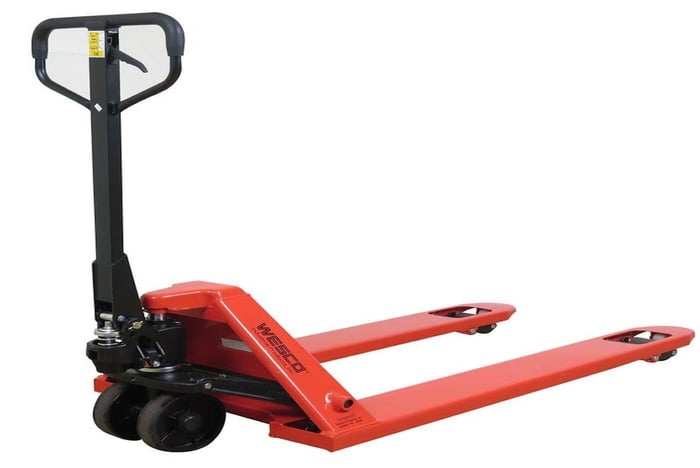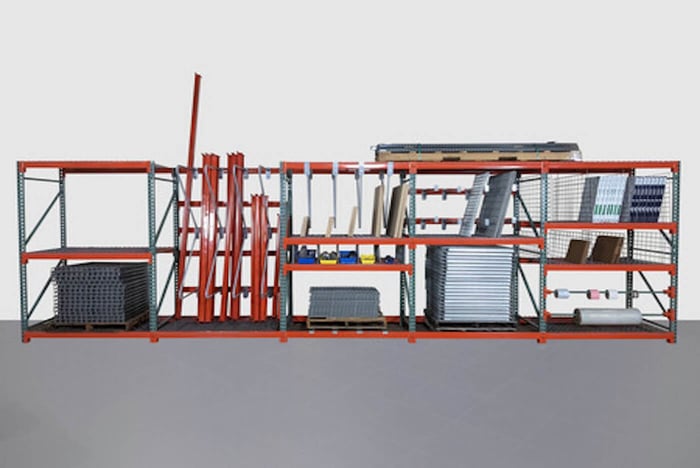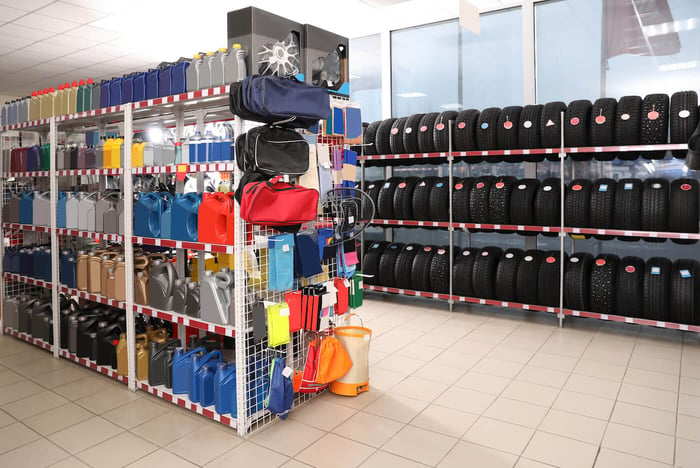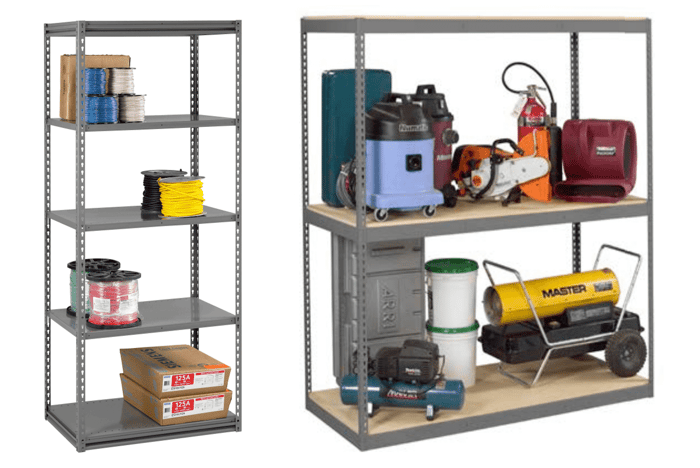What is a Pallet Jack and How is it Used in a Warehouse Setting?
A pallet jack, also known as a pallet truck, is a tool used to lift and move pallets. Pallet jacks are versatile tools that are used in many different workplaces where pallets are commonly used for storage; including warehouses, industrial, and retail settings.
Pallet jacks are some of the simpler material handling machines. They are considered to be the most simplistic form of a forklift. Although they can’t lift as heavy loads as a forklift, they are great for lower-duty lifting tasks. They are also more cost-effective and smaller than forklifts, making them easy to operate in smaller spaces.
Pallet jacks have two forks in the front and a lever that is used for steering. On manual pallet jacks, the lever also has a small handle used to lower and lift the forks. When the handle is pulled, the lever releases hydraulic fluid and lifts the forks. There are also electric pallet jacks that are powered by a motor. The motor propels the pallet jack and is used to raise and lower the forks.
Advantages of Pallet Jack Over Similar Equipment
-
Easy to Use: Pallet jacks are fairly easy to use with minimal training required.
-
Less Bulky: Pallet jacks take up less space compared to forklifts, and are easier to store and transport to job sites.
-
Cost-Effective: Pallet jacks are more affordable than some of the other equipment used to transport pallets. They also don’t typically require much maintenance.
-
Safer Alternative: Pallet jacks are much safer than forklifts to operate. They are both slower and lighter, making steering and handling easier.
Disadvantages of Pallet Jack
-
Less Practical: Pallet jacks are not compatible with certain loads and pallet types such as reversible pallets.
-
Not Very Ergonomic: Manually operated models are more difficult to maneuver and can put physical strain on the user.
-
For Low Storage: Pallet jacks only lift pallets enough off the ground to allow for transportation. They can’t be used to reach higher areas.
-
Lighter Duty: Pallet jack’s load capacity is much lower than other motorized equipment such as forklifts that can carry up to 70,000+ lbs.
What to Consider When Purchasing a Pallet Jack for your Warehouse?
There are several different options and types of pallet jack for different applications. Here are some factors to consider when purchasing a pallet jack:
Fork Size
One of the most important factors to consider is the length and width of the forks. Fork width is measured from the outermost edge on each side of the jack. And, fork length is measured from the back of the bed to the front edge. Figure out the size of your most commonly used pallets to determine what fork size you need to get. Most commonly, pallets are 40x48”, and standard size pallet jacks are 27x48”. If you end up with forks that are too long or short for your pallets, this may affect the jack’s load capacity and maneuvering ability.
Capacity
Pallet jacks come in different load-carrying capacities. Make sure to purchase a jack that will be able to handle the weight of your pallets. Using a pallet jack that isn’t equipped to carry the load can cause damage to your equipment. American Storage and Logistics carries pallet jacks with maximum load capacities ranging from 4,400 to 6,000 lbs.
Weight
Pallet jacks can also differ in their base weight. Make sure to take the base weight of the pallet jack and the added weight of the pallets into consideration when purchasing a pallet jack. Certain surfaces may not support the combined weight and can get damaged.
Lift Height
The lift height is how high a pallet jack’s forks can be raised from the ground. Standard pallet jacks are between 2 ⅞” at the lowest point, and 7 ½” at the highest. There are low-profile models that can slide into openings that are only 2 ¼” high.
Manual vs. Electric
Electric pallet jacks use a motor to move the pallet jack forward and to raise and lower the pallet. They are better suited for larger warehouses where the pallets may need to be moved over greater distances. They can also lift larger loads and may be a better option if you need increased lifting capability. However, they are more expensive and require more training for the operator.
Manual pallet jacks are usually easier to maneuver in tight spaces and may work better for smaller spaces. They are versatile and lighter than electric pallet jacks, making them easy to transport. They also cost less and do not require as much maintenance as there are no electronic parts. If the limited load weight is sufficient for your operation, the manual jack may be a good fit.
Wheel Type
Pallet jacks come with different wheels. Consider what kind of materials will be transported with the pallet jack and the ground that it will be operated on before making a decision on wheels. Some wheels are better suited for certain environmental conditions such as sloped or wet surfaces. Other materials are sturdier under heavy loads.
Nylon and polyurethane are the most common materials for pallet jack wheels. Nylon wheels are commonly used in industrial settings and are more resistant to chemicals and puncture from debris, but may be lounder than other wheel types. Polyurethane wheels are great for warehouses and retail floors. They are quiter and reduce floor markings. However, they aren’t as durable if debris is present or if they are operated on rough floors.
Different Types of Pallet Jacks
- Narrow Pallet Jacks have a narrower than usual fork width and are used to reach into narrow pallets.
- Standard Pallet Jack or general purpose manual pallet jacks are hand-powered jacks that are commonly used in warehouses or retail applications. They have fixed-width forks and are suitable to carry a wide range of loads.
- Long Fork Pallet Jacks have longer than standard forks and are used to move extra-long pallets.
- Low-Profile Pallet Jacks have a lower fork height (typically 2” or less) and they are used to enter low pallet openings where other jacks won’t fit.
- Electric Pallet Jacks are powered by an electric motor that moves the jack forward and also raises and lowers the forks. These types of jacks are easier to move and operate over long distances and can also be operated on sloped surfaces or ramps.
Selecting New Vs. Used Pallet Jacks
If you are in the market for a pallet jack, you have the option to purchase a new or used one. American Storage and Logistics carries both new and used pallet jacks. The biggest advantage to purchasing a used pallet jack is the price discount. But keep in mind that the inventory for used equipment is more limited. Furthermore, it is often up to the buyer to do due diligence on used equipment to make sure that they are purchasing a quality product. And, used equipment usually has no or shorter warranty periods. At American Storage and Logistics, our used inventory is thoroughly inspected to provide a better purchasing experience for our customers. We also offer a 90-day hydraulics warranty for our manual jacks. Our new inventory comes with 1-3 years of hydraulics warranty, depending on the brand and model. If you are not happy with your purchase for whatever reason, American Storage and Logistics also has an easy return policy for up to 15 days.
Safety Tips for Using Pallet Jacks in a Warehouse
Pallet jacks are a relatively safe piece of equipment and manual pallet jacks do not require a license to operate. However, it is always a good idea to train your employees before they use any kind of warehouse equipment. Here are some tips on how to safely operate a pallet jack:
-
Ensure that you always wear the necessary personal protective equipment when operating a pallet jack. That includes eye protection if you are moving any hazardous materials such as chemicals, safety-toed footwear to protect you from foot injuries, and gloves to protect your fingers from getting smashed.
-
Always use the pallet jack within its capacity; pay attention to the load capacity and length of the pallets.
-
Perform regular inspection and maintenance to ensure that the pallet jack is in good condition. Do not use a damaged pallet jack.
-
Make sure that the load is secured before attempting to transport or raise it.
-
Before you begin steering the pallet jack, check the floor to make sure there aren’t any bumps or obstacles in the way. These can cause the pallet jack to tip over.
-
When going on an incline, go in reverse.
For other safety tips for your warehouse, check out our article Warehouse Safety Checklist.
Check Out Our Large Online Selection of Pallet Jacks
American Storage and Logistics has been a leader in new, used, and refurbished warehouse equipment for over 50 years. We have pallet jacks in stock and we offer same-day pickup or next-day delivery to the mid-Michigan areas, including Grand Rapids, Lansing, Battle Creek, and Kalamazoo. Check out the large selection of pallet jacks on our website.





